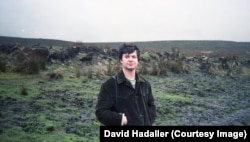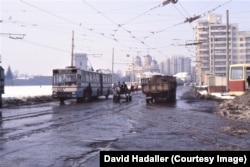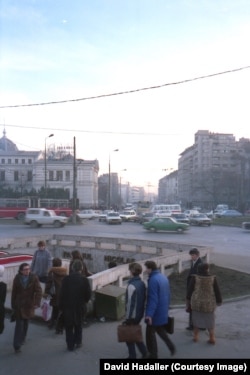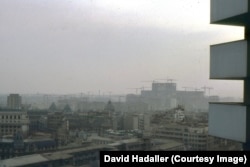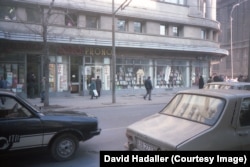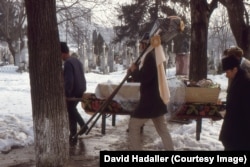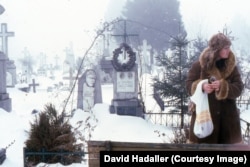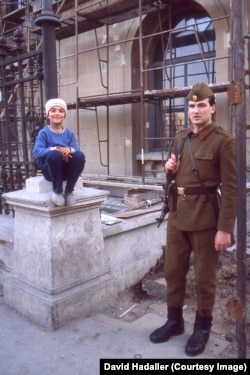In a freezing university classroom in Iasi, northeastern Romania, in 1988, American literature professor David Hadaller paused as his students scribbled notes with their hands gloved against the cold. The topic of his lecture was Henry Thoreau and the 19th-century author's entreaty to Americans to "simplify, simplify, simplify."
Like most Romanians in the 1980s, Hadaller's students were enduring the intense physical hardships that were pushing their society to a breaking point. "These Romanians have to line up just to buy bread, and I'm talking about Thoreau saying, 'simplify your life,'" Hadaller recalled to RFE/RL from his home in New York state. "I backed up midway through that lecture and I said, 'Let's talk about what 'simplify' means to you because it's a lot of nonsense coming from me.'"
Hadaller had arrived in Romania in October 1987 on a Fulbright lectureship to teach American literature and English and was there until May 1989, just months before the country exploded in revolution that finally toppled communist dictator Nicolae Ceausescu.
The 33-year-old American was one of a small number of Westerners to witness the final months of authoritarian socialism in Romania and, as a keen amateur photographer, one of the only people to have captured daily life there on color film.
The photographs Hadaller made are now being uploaded to a Facebook page, called My Fulbright Year in Romania, that has grown a following of more than 10,000 mostly Romanian subscribers who often comment with personal reflections of what the American's photos recall.
Hadaller says the images he is uploading -- mostly from the northeastern Romanian city of Iasi and the capital, Bucharest -- are striking a chord with Romanians in part because of the humdrum nature of what he documented. "I really did just photograph my day-to-day life and no one else in Romania was willing to waste color film on that," he explained. "Even black-and-white film was hard to get in the country."
This photo was posted to Facebook on January 18 and has already received more than 4,000 reactions. A Romanian woman was one of scores of people who commented with memories the shopfront revived. "We had our own [tape player] when we were little, we used to listen to Grimm fairytales," she wrote. "The bad part was that when the fairytale was over we had to turn off the [tape player]...such an effort for a sleepy child."
A commenter on this January 1988 photo remarked, "I remember those red escalators, frozen in time for so long that dirt had caked into the grooves and they were basically just fixed stairs." After the revolution, he wrote, "it was almost magical to see them functional again -- like an evil spell had been dispelled."
Another Romanian responded that the escalators "are not working right now and haven't for at least a couple of years."
Life for Hadaller during his year in Ceasescu's Romania was relatively comfortable. Unlike most locals he had access to "dollar shops," where he could buy salami, wine, and hard liquor with foreign currency. But he could not escape the shadow of state surveillance that darkened even the most innocuous personal interactions.
After hosting parties in his Iasi apartment, Hadaller says, "it got back through the informers to the rector of the university that 'Oh my God, Hadaller had students in his apartment and he was giving them wine!'" He soon came to the depressing conclusion that the Securitate, Romania's dreaded network of secret police, was likely forcing his students to report everything they heard to the authorities.
Taking photos on the street of Romania felt like a game of cat and mouse for Hadaller in the dystopian surveillance state. He used a Pentax K1000 SLR that he kept hidden under his jacket between shots, and a Vivitar camera small enough to keep in his pocket. "I was very furtive about it," he said of his photo walks, "as a result, around 30 percent of my photos were blurry."
Many images were simply too risky to attempt for the young American. "Everywhere I went, especially in train stations or bus stops, there were signs up of a camera with a line through it saying 'interzis,' the Romanian word for 'forbidden.'"
It was unclear what the penalty would be if Hadaller was spotted taking photos, but he said, "I did not want my cameras confiscated by these people because who knew what a street cop might do, I had no idea."
Hadaller was able to ship his films out of Romania through a diplomatic mailbag that customs officers are not supposed to open. He left the country in May 1989 and watched from the United States in December that year as reports trickled in from Romania about a violent revolution.
The American was able to return to Romania in March 1990, just after the revolution and in time to witness some of the political aftershocks that continued to rattle the country. He married his fiancee, a Romanian woman he had met while teaching, that month.
When he eventually accessed his Securitate file, Hadaller discovered that as he was secretly photographing Romania, communist agents had been secretly photographing him and his future wife with almost the same furtiveness.

